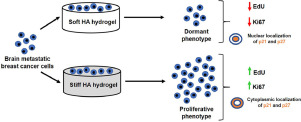当前位置:
X-MOL 学术
›
Acta Biomater.
›
论文详情
Our official English website, www.x-mol.net, welcomes your
feedback! (Note: you will need to create a separate account there.)
An in vitro hyaluronic acid hydrogel based platform to model dormancy in brain metastatic breast cancer cells.
Acta Biomaterialia ( IF 9.4 ) Pub Date : 2020-02-29 , DOI: 10.1016/j.actbio.2020.02.039 Akshay A Narkhede 1 , James H Crenshaw 1 , David K Crossman 2 , Lalita A Shevde 3 , Shreyas S Rao 1
Acta Biomaterialia ( IF 9.4 ) Pub Date : 2020-02-29 , DOI: 10.1016/j.actbio.2020.02.039 Akshay A Narkhede 1 , James H Crenshaw 1 , David K Crossman 2 , Lalita A Shevde 3 , Shreyas S Rao 1
Affiliation

|
Breast cancer cells (BCCs) can remain dormant at the metastatic site, which when revoked leads to formation of metastasis several years after the treatment of primary tumor. Particularly, awakening of dormant BCCs in the brain results in breast cancer brain metastasis (BCBrM) which marks the most advanced stage of the disease with a median survival period of ~4-16 months. However, our understanding of dormancy associated with BCBrM remains obscure, in part, due to the lack of relevant in vitro platforms to model dormancy associated with BCBrM. To address this need, we developed an in vitro hyaluronic acid (HA) hydrogel platform to model dormancy in brain metastatic BCCs via exploiting the bio-physical cues provided by HA hydrogels while bracketing the normal brain and metastatic brain malignancy relevant stiffness range. In this system, we observed that MDA-MB-231Br and BT474Br3 brain metastatic BCCs exhibited a dormant phenotype when cultured on soft (0.4 kPa) HA hydrogel compared to stiff (4.5 kPa) HA hydrogel as characterized by significantly lower EdU and Ki67 positivity. Further, we demonstrated the nuclear localization of p21 and p27 (markers associated with dormancy) in dormant MDA-MB-231Br cells contrary to their cytoplasmic localization in the proliferative population. We also demonstrated that the stiffness-based dormancy in MDA-MB-231Br cells was reversible and was, in part, mediated by focal adhesion kinases and the initial cell seeding density. Finally, RNA sequencing confirmed the dormant phenotype in MDA-MB-231Br cells. This platform could further our understanding of dormancy in BCBrM and could be adapted for anti-metastatic drug screening. STATEMENT OF SIGNIFICANCE: Our understanding of dormancy associated with BCBrM remains obscure, in part, due to the lack of relevant in vitro platforms to model dormancy associated with BCBrM. Herein, we present a HA hydrogel-based platform to model dormancy in brain metastatic BCCs while recapitulating key aspects of brain microenvironment. We demonstrated that the biophysical cues provided the HA hydrogel mediates dormancy in brain metastatic BCCs by assessing both proliferation and cell cycle arrest markers. We also established the role of focal adhesion kinases and initial cell seeding density in the stiffness-mediated dormancy in brain metastatic BCCs. Further, RNA-seq. confirmed the dormant phenotype in brain metastatic BCCs. This platform could be utilized to further our understanding of microenvironmental regulation of dormancy in BCBrM.
中文翻译:

基于体外透明质酸水凝胶的平台,用于模拟脑转移性乳腺癌细胞的休眠。
乳腺癌细胞 (BCC) 可以在转移部位保持休眠状态,当原发肿瘤治疗后数年被撤销导致转移形成。特别是,大脑中休眠的 BCC 的唤醒会导致乳腺癌脑转移 (BCBrM),这标志着该疾病的最晚期阶段,中位生存期约为 4-16 个月。然而,我们对与 BCBrM 相关的休眠的理解仍然模糊,部分原因是缺乏相关的体外平台来模拟与 BCBrM 相关的休眠。为了满足这一需求,我们开发了一种体外透明质酸 (HA) 水凝胶平台,通过利用 HA 水凝胶提供的生物物理线索来模拟脑转移性基底细胞癌的休眠,同时将正常大脑和转移性脑恶性肿瘤相关的刚度范围括起来。在这个系统中,我们观察到,与硬 (4.5 kPa) HA 水凝胶相比,MDA-MB-231Br 和 BT474Br3 脑转移性 BCC 在软 (0.4 kPa) HA 水凝胶上培养时表现出休眠表型,其特点是 EdU 和 Ki67 阳性率显着降低。此外,我们证明了休眠 MDA-MB-231Br 细胞中 p21 和 p27(与休眠相关的标记)的核定位与其在增殖群体中的细胞质定位相反。我们还证明了 MDA-MB-231Br 细胞中基于刚度的休眠是可逆的,并且部分是由粘着斑激酶和初始细胞接种密度介导的。最后,RNA 测序证实了 MDA-MB-231Br 细胞的休眠表型。该平台可以加深我们对 BCBrM 休眠的理解,并可用于抗转移药物筛选。重要性声明:我们对与 BCBrM 相关的休眠的理解仍然模糊,部分原因是缺乏相关的体外平台来模拟与 BCBrM 相关的休眠。在此,我们提出了一个基于 HA 水凝胶的平台来模拟脑转移性基底细胞癌的休眠,同时概括脑微环境的关键方面。我们通过评估增殖和细胞周期停滞标志物证明,提供 HA 水凝胶的生物物理线索可介导脑转移性基底细胞癌的休眠。我们还确定了粘着斑激酶和初始细胞接种密度在脑转移性基底细胞癌中刚度介导的休眠中的作用。此外,RNA-seq。证实了脑转移性基底细胞癌的休眠表型。该平台可用于加深我们对 BCBrM 休眠微环境调控的理解。
更新日期:2020-03-02
中文翻译:

基于体外透明质酸水凝胶的平台,用于模拟脑转移性乳腺癌细胞的休眠。
乳腺癌细胞 (BCC) 可以在转移部位保持休眠状态,当原发肿瘤治疗后数年被撤销导致转移形成。特别是,大脑中休眠的 BCC 的唤醒会导致乳腺癌脑转移 (BCBrM),这标志着该疾病的最晚期阶段,中位生存期约为 4-16 个月。然而,我们对与 BCBrM 相关的休眠的理解仍然模糊,部分原因是缺乏相关的体外平台来模拟与 BCBrM 相关的休眠。为了满足这一需求,我们开发了一种体外透明质酸 (HA) 水凝胶平台,通过利用 HA 水凝胶提供的生物物理线索来模拟脑转移性基底细胞癌的休眠,同时将正常大脑和转移性脑恶性肿瘤相关的刚度范围括起来。在这个系统中,我们观察到,与硬 (4.5 kPa) HA 水凝胶相比,MDA-MB-231Br 和 BT474Br3 脑转移性 BCC 在软 (0.4 kPa) HA 水凝胶上培养时表现出休眠表型,其特点是 EdU 和 Ki67 阳性率显着降低。此外,我们证明了休眠 MDA-MB-231Br 细胞中 p21 和 p27(与休眠相关的标记)的核定位与其在增殖群体中的细胞质定位相反。我们还证明了 MDA-MB-231Br 细胞中基于刚度的休眠是可逆的,并且部分是由粘着斑激酶和初始细胞接种密度介导的。最后,RNA 测序证实了 MDA-MB-231Br 细胞的休眠表型。该平台可以加深我们对 BCBrM 休眠的理解,并可用于抗转移药物筛选。重要性声明:我们对与 BCBrM 相关的休眠的理解仍然模糊,部分原因是缺乏相关的体外平台来模拟与 BCBrM 相关的休眠。在此,我们提出了一个基于 HA 水凝胶的平台来模拟脑转移性基底细胞癌的休眠,同时概括脑微环境的关键方面。我们通过评估增殖和细胞周期停滞标志物证明,提供 HA 水凝胶的生物物理线索可介导脑转移性基底细胞癌的休眠。我们还确定了粘着斑激酶和初始细胞接种密度在脑转移性基底细胞癌中刚度介导的休眠中的作用。此外,RNA-seq。证实了脑转移性基底细胞癌的休眠表型。该平台可用于加深我们对 BCBrM 休眠微环境调控的理解。











































 京公网安备 11010802027423号
京公网安备 11010802027423号